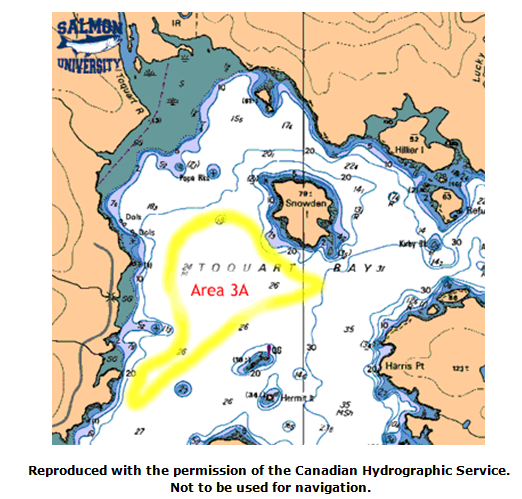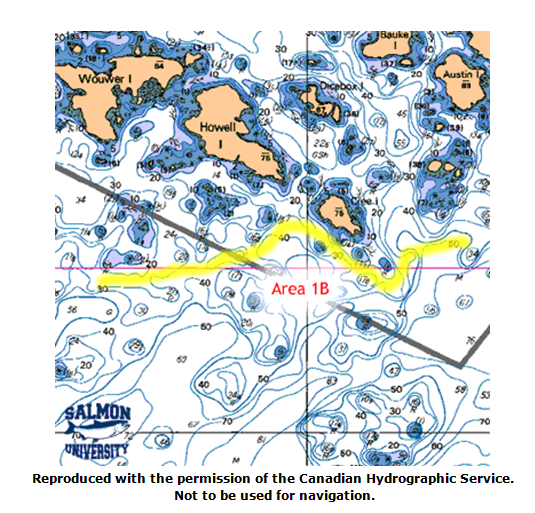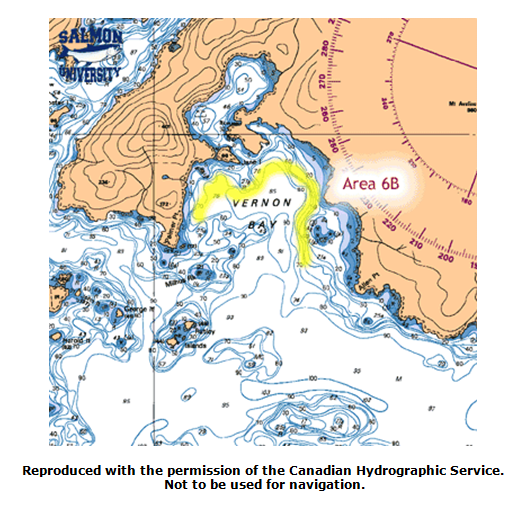Barkley Sound
 Barkley Sound is located on the Western shore of Vancouver Island. Stretching from Ucluth Peninsula in the north to Cape Beale in the south, Barkley Sound offers some of the most spectacular fishing for salmon, halibut and bottom fish on the entire North American continent.
Barkley Sound is located on the Western shore of Vancouver Island. Stretching from Ucluth Peninsula in the north to Cape Beale in the south, Barkley Sound offers some of the most spectacular fishing for salmon, halibut and bottom fish on the entire North American continent.
Whether you’re fishing in the sheltered waters of Barkley Sound or on the banks off-shore, you’re in the migration path of millions of salmon. Salmon migrating south from Southeast Alaska, the Queen Charlotte Islands and northern British Columbia all pass these shores and many return to Barkley Sound itself to spawn in the local rivers and streams.
All five species of salmon are here: Chinook, Coho, Humpies, Chum and Sockeye will migrate through this area from early spring until late fall. These salmon are returning to Northern California, Oregon and Washington rivers as well as the mighty Fraser River and many local British Columbia streams.
While Barkley Sound is widely recognized for its excellent summer fishery, it really offers year round opportunity as the sound and offshore waters serve as a nursery for salmon and halibut.
Fish Calendar
January through April – Feeder Chinook (Blackmouth) are the dominate fishery in this area. Weather allowing, you can fish the banks offshore but, if the weather doesn’t cooperate, anglers fishing from the port town of Ucluelet can usually find sheltered water that allows them to go out. Blackmouth (especially in April and May) can be taken that top thirty pounds.
May and June – Chinook begin to migrate south and are very active feeders. Many Chinook are in the 25 to 35 pound range. Because these Chinook are preparing for their spawning runs, they are voracious in attacking herring, spawning candlefish and your fishing lures. Also, Halibut show up in big numbers to feed on the same bait fish, both in Barkley Sound and the offshore rock piles.
July – While the offshore runs continue to move south wave after wave, local salmon and dip-ins begin to show in ever increasing numbers in Barkley Sound. Sockeye return to Alberni Inlet and an outstanding fishery is available directly in front of Port Alberni itself. Some halibut will remain in Barkley Sound, but most will move to the offshore banks and rock piles.
August and September – Salmon fishing explodes as Coho in good size and great numbers join the mix. Humpies will also be present in great numbers, as will sockeye and Chum.
October – Everyone has gone home except for some of the largest Chinook and Coho of the year. October weather is often mild and Chinook in the fifty and Coho in the twenty pound range are still coming through. Chums, perhaps pound for pound, are going to be your hardest fighting salmon, ocean fresh and in great numbers.
November to December – The weather can be the main factor as the first of the great winter storms roll in off the ocean. Bottom fish and Halibut will be available and the first of the Blackmouth will begin to arrive.
Fishing Ports
There are three main fishing ports with docking, stores, gas, guides, etc., for the sports fisherman. The first is to the north of Barkley Sound at Ucluelet. This is a town of about 1,600 people with stores, gas, tackle, restaurants and shops a short walk from the dock. This area is best known for the Oak Bay Marine Group, party boats and motels.
The angler who wishes to fish in smaller groups will find charters available at Island West Fishing Resort. For those anglers who are towing their own boats, Island West also has moorage available for up to eighty boats. There is also ample moorage available at the public docks.
In addition to its other amenities, Island West also has an RV Park with hook-ups, a campground, public showers and a nice boat launch.
The second port is Bamfield. Bamfield has many of the same facilities as Ucluelet but is a much smaller town which is divided by an inlet. It’s a long, rough drive towing a boat to Bamfield and it is usually easier to launch at Port Alberni or China Creek campground and run your boat out. This is a trip of about twenty-five to thirty miles, depending on where you start. The early morning water in Alberni Inlet is usually calm, but as the weather heats up in the summer, the winds are sucked down between the mountains and the water can become quite rough. As you reach Barkley Sound the water will usually lay down.
The third port is Port Alberni. A town of about 25,000, it offers a full range of services, dock, motels and nearby China Creek campground. Port Alberni is aggressively pursuing tourist trade, especially sports fishermen. The Somass River enters Alberni Inlet here, so all salmon returning to the state-of-the-art Robinson Creek Hatchery are literally under your feet when you’re on the water. Port Alberni is where most of the sports sockeye fishery takes place.
Areas to Fish
Ucluelet

Area 1A – Amphitrite Point: Sometimes this area is referred to as First, Second and Third Beach. An excellent Chinook area with only a short run from Ucluelet. In July and August this area can become quite crowded but is a great spot for mooching and jigging. Boats going up in the surf in shallow water really pull out some big Chinook. Trollers can move out deeper and do quite well.

Area 2A – Newcombe Channel: This is a good area for protected fishing. Chinook are available and peak in May, June and August to September. Feeder Chinook are available year round. Work the 100 to 120 foot depths.

Area 3A – Toquart Bay: Good winter fishing for feeder Chinook and some fishing for summer Chinook. Humpies will school up in this Bay. An unimproved campground and small boat launching ramp is located here. No docks available.

Area 1B – Cree Island: Work the drop offs and reefs. Best in July and August for Chinook. Stay in 90 to 100 feet of water. You don’t have to drag the bottom as the Chinook suspend themselves in the top sixty feet of water.

Area 2B – Effingham Island: A good area for both Chinook and Coho. You can actually troll from Cree Island, along the southern face of Effingham. The south side of Effingham can be windy and fog seems to love this spot.

Area 3B – Gibraltar Island: A good spot for Chinook coming out of the Coaster Channel. Fish Coho further out in the Imperial Channel. Just find the tide rips and fish along them for Coho.
Area 4B – Sechart Channel: Fish the 60 to 100 foot water depths for Chinook.
Area 5B – Howard Point: Good for Chinook in August and September.

Area 6B – Vernon Bay: An excellent area for winter blackmouth. Fish the bottom twenty feet of water.
Bamfield

Area 1C – Cape Beale: This is one of the real hot spots. If you’re a troller, just get in line and follow the other boats. An outstanding area for moochers and jiggers. When jiggers start picking up candle fish on their jigs hold on the bites coming! Moochers and jiggers should work the 20 to 80 foot water depths. Salmon are often taken very near to shore. This area is exposed to winds and has strong tidal flows so be aware.
Area 2C – A good troll anytime from Aquilar Point to Whittlestone Point. This area is protected from the winds. On the incoming tide troll from Whittlestone Point to Aguilar and vice-versa on the outgoing tide. Best months are January to March for feeder Chinook and August and September for Chinook in the twenty to fifty pound range.

Area 3C – Bamfield Inlet: Start fishing immediately after crossing the mouth of Grappler Inlet. Stay in the fifty to seventy water depths early in the morning. After rounding the point, continue your troll down to Ellis Light. This area is often referred to as the wall. As the sun comes up move to deeper water.
Area 4C – Numukamis Bay: A good year-round area for Chinook and a good fall area for Coho and Sockeye who often school here before heading down to Alberni Inlet. A small resort is located in Poett Nook.
Area 5C – Rainy Bay: Work Chup Point for Chinook in August and September. A great spot for Coho.
Area 6C – North Side of Tzartus Island: This area is good for Chinook and Coho but can be very hard on tackle.

Area 7C – Fleming Island: A great spot for evening fishing; very little pressure and close to Bamfield. A good evening Chinook fishery but also an area that collects downrigger balls.
Special Notes
The areas you may wish to fish off-shore are as follows: South Bank is approximately seven miles due south of the light as you leave Ucluelet.
Southwest Bank Corner is about 12.5 miles southwest of the lighthouse. This also holds salmon and halibut the year around.
Both of these banks should be fished right on the bottom for both Chinook and halibut.
In August and September, Wya Point is very popular for Chinook and Coho. Wya Point is about 5 miles up the coast from Amphitrite Point.
Fishing Tips
Since Barkley Sound and the surrounding area will have, literally, millions of salmon passing by, it’s not all that hard to catch one, regardless of method. However, here are some tips that will help you out.
On the offshore banks, trolling on the bottom and letting your downrigger ball bounce occasionally will help attract both salmon and halibut. The more scents you use, such as Smelly Jelly, the more likely you’ll be able to pick-up halibut while trolling. And, of course, this will also help you attract salmon.
The July/August/September Chinook and Coho run isn’t always a drag-your-lure-on-the-bottom fishery. They will often suspend and, if you have good electronics you’ll be able to spot both the fish and the bait and target your downrigger fishing to this depth.
Often you need to fish no deeper than thirty-five feet below the surface. Moochers and jiggers can work the surf-lines quite close to shore and trollers should stay close to the edges of kelp beds for the really big Chinook. Coho will also feed along the edge of these kelp beds.
Lures
A number of lures will work for Chinook and Coho. Most guides use the tried and true method of a Hot Spot flasher trolling a herring or anchovy fifty-five to seventy inches behind their flasher.
Artificial lures work exceptionally well and some you might want to have in your tackle box or, more importantly, in the water would include:
1. The Silver Horde Coho Killer, an especially deadly lure on the outer banks. Army truck and glow colors are both excellent to use.
2. The Sonic Edge spoon in copper/watermelon color #323 works well both behind a flasher or trolled by itself. Fish this lure in the top sixty feet of water.
3. The #4 Kingfisher spoon in Cop Car color #911 is a great spoon to fish either behind a flasher or by itself.
4. Last, but not least, the Pro-Troll Roto Chip with herring, or herring strip, can be deadly in this area. The Roto Chip lure contains the E-Chip which, when being tested, showed an increased catch rate compared against like lures.
How to Fish for Salmon | How to Catch Salmon | How to Fish for Tuna | How to Catch Tuna | How to Fish for Halibut | How to Catch Halibut









